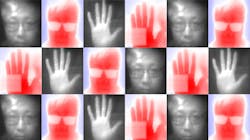Quantum dots could make IR cameras cheaper, more widely available
There's an entire world our eyes miss that infrared cameras can pick up; for example, shortwave infrared (SWIR) cameras see through fog and haze, midwave infrared (MWIR) devices monitor temperature across of warm objects and areas for industry, and longwave infrared (LWIR) cameras passively image room-temperature objects.
But IR cameras are more expensive than visible-light ones. A new IR camera architecture developed by scientists at the University of Chicago, however, may one day lead to more cost-effective infrared cameras that also can image in more than one IR band.1 Such cameras could be widely used in the consumer and industrial arenas.
"Traditional methods to make infrared cameras are very expensive, both in materials and time, but this method is much faster and offers excellent performance," says postdoctoral researcher Xin Tang.
Today's IR cameras are made by successively laying down multiple layers of semiconductors, an error-prone process that makes them too expensive to go into most consumer electronics. Instead, Tang, professor Guyot-Sionnest, and other researchers instead turned to colloidal quantum dots a few nanometers in size tuned to pick up wavelengths of infrared light. They tweaked the quantum dots so that some detected SWIR and others detected MWIR. Then they laid both together in separate layers on top of a silicon wafer.
The resulting camera performs extremely well and is much easier to produce. "It's a very simple process," Tang says. "You take a beaker, inject a solution, inject a second solution, wait five to 10 minutes, and you have a new solution that can be easily fabricated into a functional device."
Rapid switching between bands
The resulting camera can be switched between SWIR and MWIR detection at 100 kHz rates simply by controlling the bias polarity and magnitude.
There are many potential uses for inexpensive IR cameras, the scientists says, including autonomous vehicles. Infrared can detect heat signatures from living beings and see through fog or haze, so car engineers would like to include them, but the cost is prohibitive.
They would come in handy for scientists, too. "If I wanted to buy an infrared detector for my laboratory today, it would cost me $25,000 or more," Guyot-Sionnest says. "But they would be very useful in many disciplines. For example, proteins give off signals in infrared, which a biologist would love to easily track."
The other authors on the paper were graduate students Matthew Ackerman and Menglu Chen. Matthew Ackerman conceived of the device with Tang and developed the doping strategy for the fabrication of the diodes.
Source: https://news.uchicago.edu/story/breakthrough-could-enable-infrared-cameras-electronics-self-driving-cars
REFERENCE:
1. Xin Tang et al., Nature Photonics (2019); https://doi.org/10.1038/s41566-019-0362-1
About the Author
John Wallace
Senior Technical Editor (1998-2022)
John Wallace was with Laser Focus World for nearly 25 years, retiring in late June 2022. He obtained a bachelor's degree in mechanical engineering and physics at Rutgers University and a master's in optical engineering at the University of Rochester. Before becoming an editor, John worked as an engineer at RCA, Exxon, Eastman Kodak, and GCA Corporation.

